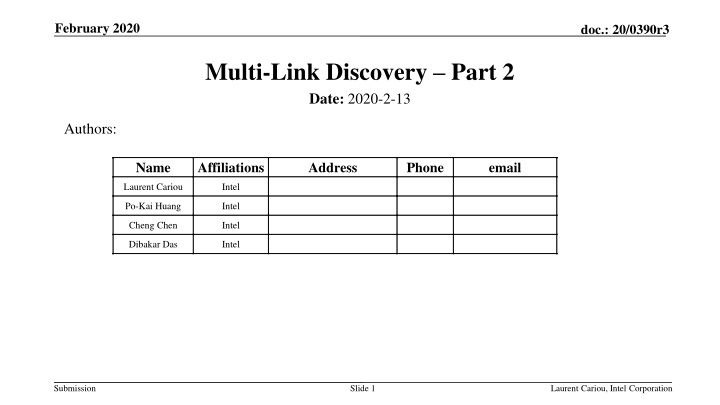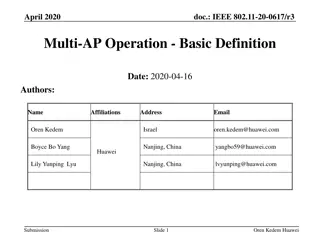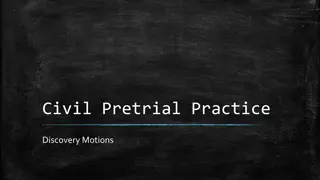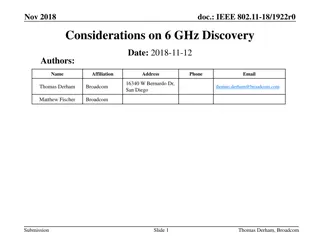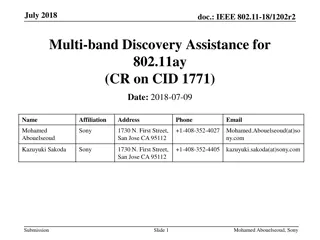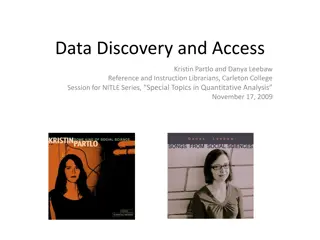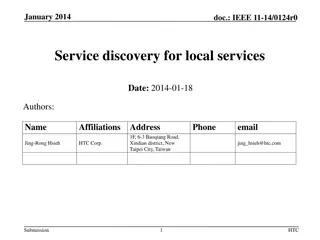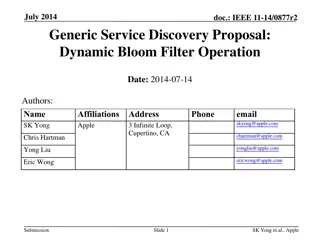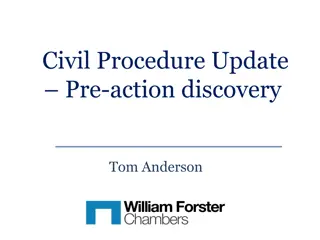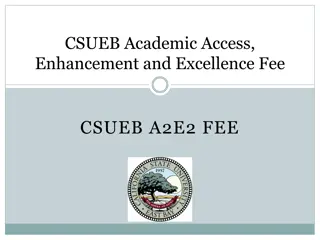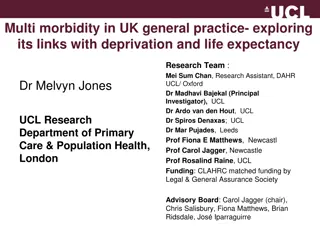Multi-Link Discovery in February 2020: AP Information Enhancement
The document discusses enhancing AP information in beacons/probe responses, proposing using Link ID to avoid duplicating information already present in the RNR. It explores carrying complete AP information within the same MLD using Neighbor reports and new elements.
Download Presentation

Please find below an Image/Link to download the presentation.
The content on the website is provided AS IS for your information and personal use only. It may not be sold, licensed, or shared on other websites without obtaining consent from the author.If you encounter any issues during the download, it is possible that the publisher has removed the file from their server.
You are allowed to download the files provided on this website for personal or commercial use, subject to the condition that they are used lawfully. All files are the property of their respective owners.
The content on the website is provided AS IS for your information and personal use only. It may not be sold, licensed, or shared on other websites without obtaining consent from the author.
E N D
Presentation Transcript
February 2020 doc.: 20/0390r3 Multi-Link Discovery Part 2 Date: 2020-2-13 Authors: Name Affiliations Address Phone email Laurent Cariou Intel Po-Kai Huang Intel Cheng Chen Intel Dibakar Das Intel Submission Slide 1 Laurent Cariou, Intel Corporation
February 2020 doc.: 20/0390r3 Objectives In part 1, we talked about the information that is carried in beacons and probe responses Especially looking at the minimum information that will be mandated to be included in beacons/probes, and the natural use of RNR for this purpose Define a way to probe an AP that is part of an AP MLD to collect the complete information on all the APs of the AP MLD Submission Slide 2 Laurent Cariou, Intel Corporation
February 2020 doc.: 20/0390r3 Including complete information in beacons/probes If we agree with the previous concepts: Beacons/probe responses always include RNR Some probe responses (MLD probing) will also include complete information for APs for the same MLD Beacon may also include complete information for APs for the same MLD If beacons/probes responses include the complete information for APs from the same MLD, we need a way to carry those information (Neighbor report, Multi-band element, new element), having in mind that we already have an RNR that is already included in most if not all the cases It would be useful to find solutions to not have to duplicate the information already present in the RNR (14 Bytes: TBTT offset, BSSID, short SSID, BSS parameters, Operating Class/Channel) We could use the concept of Link ID for different APs within an MLD, the same way we use BSSID-index for different APs within a multiple BSSID set Submission Slide 3 Laurent Cariou, Intel Corporation
February 2020 doc.: 20/0390r3 AP 1 2.4 GHz AP 2 5 GHz AP 3 6 GHz AP MLD SSID S AP2 AP3 Beacon Regular elements for AP1 RNR Beacon frame sent by AP1 Regular probe request sent to AP1 (directed using AP1 BSSID or using AP1 SSID, or wildcard SSID) Regular probe AP2 AP3 Regular elements for AP1 RNR Regular Probe response MLD probe request sent to AP1 (directed using AP1 BSSID or using AP1 SSID, or wildcard SSID) - asking for complete AP MLD information MLD probe AP2 AP3 AP2 complete info Regular elements for AP1 AP3 complete info RNR ML MLD Probe response AP MLD MAC address (re)assoc STA2 complete info AP2 complete info Regular elements for STA1 Regular elements for AP1 STA3 complete info AP3 complete info Non-AP MLD MAC address ML ML (re)association request frame (re)association response frame Submission Slide 4 Intel Corporation
February 2020 doc.: 20/0390r3 Optionally: possibility to include complete information in beacon AP2 AP3 AP2 complete info Regular elements for AP1 AP3 complete info RNR ML Beacon frame sent by AP1 Submission Slide 5 Intel Corporation
February 2020 doc.: 20/0390r3 Use of this ML element In the vast majority of cases, only basic information will be provided in the RNR in beacons/probe responses of AP that are part of AP MLDs, in order not to unnecessarily bloat the beacon. In the rare case where the AP wants to provide the complete information, the ML element can be used in complement of the RNR This element would be used more frequently in probe response when the probe request contains a specific indication (MLD request) that it wants the complete information on all APs of the AP MLD Probe responses sent in response to a probe request directed to an AP of the AP MLD would only contain information on the AP and basic information of AP MLD through RNR The element can also be used for a non-AP MLD (or an AP MLD) to describe the different non-AP STAs (or AP STAs) on different link during the multi-link setup phase. Submission Slide 6 Laurent Cariou, Intel Corporation
February 2020 doc.: 20/0390r3 ML element We propose to define a new Multi-Link element to describe the different APs of an AP MLD, which follows a similar structure as the Multiple BSSID element. It includes multiple AP profile subelements or fields (one for each reported AP of the AP MLD) that contains a list of elements: All the elements included in beacons/probe responses can be included in the AP profile The AP in the AP profile is identified by its unique Link ID in the AP MLD (equivalent here of the multiple BSSID-index) We propose to use an inheritance concept similar to the one used for multiple BSSID element Submission Slide 7 Laurent Cariou, Intel Corporation
February 2020 doc.: 20/0390r3 ML element and Multiple BSSID ML element can be included in a nontransmitted BSSID profile of a multiple BSSID set to describe the APs of the same MLD as the AP with the corresponding BSSID-Index - Everything should work fine, including inheritance, if we do it as proposed in previous slide and assume that the reference for inheritance is the non-transmitted BSSID - Inheritance when ML element is included in a nontransmitted BSSID profile The reference for inheritance of the AP in the AP profile is the nontransmitted BSSID Submission Slide 8 Laurent Cariou, Intel Corporation
February 2020 doc.: 20/0390r3 Use case: - In multi-link setup: there shouldn t be Multiple BSSID element - In beacon or unsolicited probe response, this could happen if an AP provides complete information for other APs in the MLD, and does not limit itself to RNR - In MLD probe response in response to a directed probe request to a non-transmitted BSSID, the transmit BSSID sends it on behalf of the non-transmitted BSSID, and include a Multiple BSSID element with a non-transmitted BSSID profile, which would include an ML element if part of an MLD - MLE Inheritance Elements for AP3-2.4 Link ID1 profile Elements for AP3-5 LinkID2 profile Elements for AP2-2.4 Link ID1 profile Elements for AP2-5 LinkID2 profile Elements for AP3-6 Elements for AP2-6 ML element ML element Non-transmitted BSSID profile (AP2-6) BSSID-index 2, SSID2 Non-transmitted BSSID profile (AP3-6) BSSID-index 3, SSID3 MBSSID Inheritance Multiple BSSID element Beacon frame sent by AP1-6 (SSID1) Submission Slide 9 Laurent Cariou, Intel Corporation
February 2020 doc.: 20/0390r3 Inheritance framework proposal Without Multiple BSSID Define the inheritance mechanism, similar to 11ax, so that the value of an element of a reported STA that is not present in a STA profile of a ML element in a frame sent by a reporting STA is the same as the element of the reporting STA, present elsewhere in the frame. With Multiple BSSID Define the inheritance mechanism, similar to 11ax, so that the value of an element of a reported STA that is not present in a STA profile of a ML element included in a non- transmitted BSSID profile of a non-transmitted BSSID in a multiple BSSID element in a frame sent by a reporting STA is the same as the element of the non-transmitted BSSID, present elsewhere in the frame or as the element of the reporting STA, present elsewhere in the frame. Submission Slide 10 Laurent Cariou, Intel Corporation
February 2020 doc.: 20/0390r3 Straw polls SP1 Do you agree to define a new Multi-Link element (MLE) to report/describe multiple STAs of an MLD with at least the following characteristics? MLD-level information may be included A STA profile subelement is included for each reported STA (if any) and is made of a variable number of elements describing this STA Submission Slide 11 Laurent Cariou, Intel Corporation
February 2020 doc.: 20/0390r3 Straw polls SP2 Do you support that, for the ML element, we define an inheritance model to prevent frame bloating when advertising complete information of other links? Define the inheritance mechanism, similar to 11ax, so that the value of an element of a reported STA that is not present in a STA profile of a ML element in a frame sent by a reporting STA is the same as the element of the reporting STA, present elsewhere in the frame. Define the inheritance mechanism, similar to 11ax, so that the value of an element of a reported STA that is not present in a STA profile of a ML element included in a non-transmitted BSSID profile of a non-transmitted BSSID in a multiple BSSID element in a frame sent by a reporting STA is the same as the element of the non-transmitted BSSID, present elsewhere in the frame or as the element of the reporting STA, present elsewhere in the frame. Note: an element of a STA refers in the text above to the instance of the element describing the capabilities/operation/functionalities of that STA, in a frame where multiple instances of the element can be found for other STAs. Note: some elements may not be inherited, signaling TBD Submission Slide 12 Laurent Cariou, Intel Corporation
February 2020 doc.: 20/0390r3 Neighbor report Neighbor report allows discovery of neighbor APs (ANQP NRs, BTM, ) and is used as part of MBO (multi-band operation) It is unlikely that we ll use Neighbor report to report collocated APs within the same AP MLD Neighbor report will however likely be used to report on neighboring AP MLDs, or APs that are part of neighboring AP MLDs We need a way to identify that an AP reported in a NR is part of an AP MLD Indication that it is an EHT AP (if we mandate that all EHT APs are AP MLDs) Indication that it is part of an AP MLD Probably good to also have a way to report all the APs of an AP MLD, with a way to know that these reported APs are all part of the same AP MLD Submission Slide 13 Laurent Cariou, Intel Corporation
February 2020 doc.: 20/0390r3 Straw polls SP3 Do you agree to include in the BSSID Information field of the NR a way to indicate that the AP is part of an AP MLD? Do you agree to be able to report all the APs of an AP MLD in a BTM frame, with a way to know that these reported APs are all part of the same AP MLD? Submission Slide 14 Laurent Cariou, Intel Corporation
